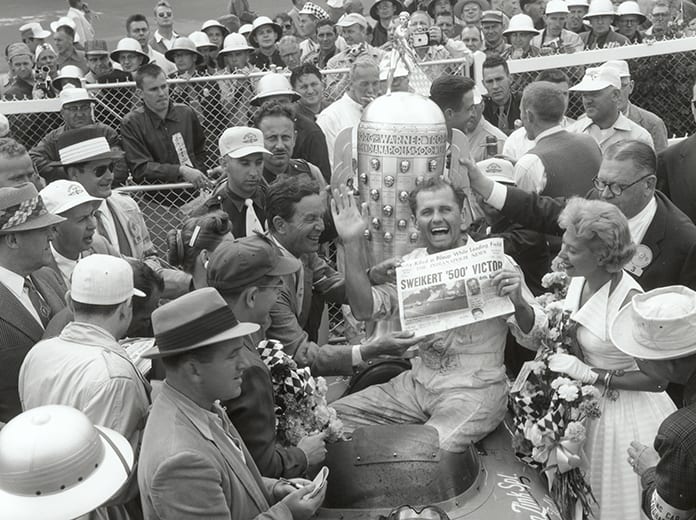Editor’s Note: What follows is the text of the race report covering the inaugural Hoosier Hundred at the Indiana State Fairgrounds from the Sept. 30, 1953 issue of National Speed Sport News.
INDIANAPOLIS — Bob Sweikert sprinted 100 miles to victory at the Indiana State Fairgrounds to outrun a closely bunched quartet of veteran mile runners and capture the first annual Hoosier Hundred before some 18,000 cheering fans who were on their feet during the final 10 laps to witness the climactic finish.
The 27-year-old driver stood off repeated challenges by Manuel Ayulo, Johnnie Parsons and Don Freeland during the late stages of the race with the first four whizzing over the finish line only nine-tenths of a second apart.
Never, according to drivers, fans and race officials, has there been a 100-mile dirt-track race packed with such a wallop as the final 50 laps of the Hoosier Hundred debut.
Sweikert who had been dogged with mechanical failure and a crash in recent 100 milers, set a new track record with a speed of 87.20 mph, besting the previous speed of 79.80 set by the late Rex Mays in 1946.
The race was minus any accidents although Tony Bettenhausen hit the outside fence on the east turn and broke the right-rear wheel while battling with Parsons for the No. 4 running spot.
However, a 30-second pit stop enabled Tony to salvage sixth over 10 non-stop runners with 17 cars completing the race out of the 18-car starting field. LeRoy Warriner was out on the 51st lap with a broken crankshaft in the Lubri-Loy.

Sweikert’s share of the $26,250 purse amounted to $6,751 of which $1,350 was from lap prize and accessory awards. He also won a diamond-studded wrist watch and the HARF Driving Jacket Award.
Running under the proverbial blanket at the finish behind Sweikert were Ayulo who led the race for the first two laps, Parsons and Freeland.
Sam Hanks gathered enough points from his fifth finishing spot to put him in a good position to cop the 1953 national championship with only Sacramento and Phoenix yet to go with Rodger Ward and Bettenhausen finishing over for sixth and sevent.
Pat O’Connor, current point leader in the Midwest Sprint Circuit, picked up five spots from 12th starting position to finish eighth in the Hopkins with Ed Elisian, Chuck Weyant and Duane Carter following close behind.
The track was in excellent condition and the day completely free of accidents with a few minor spins and Bettenhausen’s wall slap comprising the total.
There was an indication of things to come during time trials when eight different drivers topped the old one-lap record set by Tony Willman in 1941 with Ayulo finally establishing the record with a 37.47-second run.
So tremendously successful was the race that it left no doubt about the future of the Hoosier Hundred, which if matched in coming years seems destined to become one of the top classics of the auto racing world.
